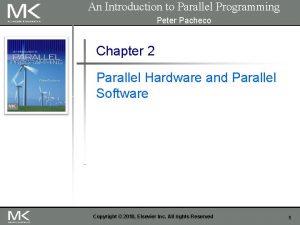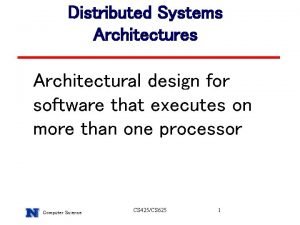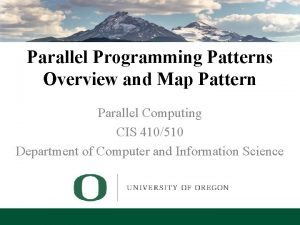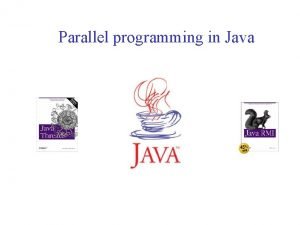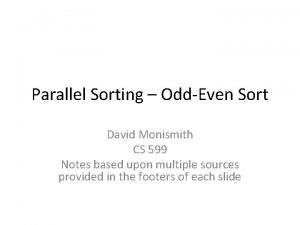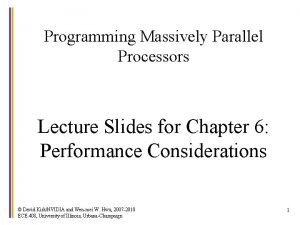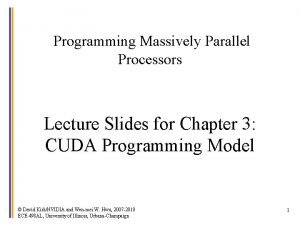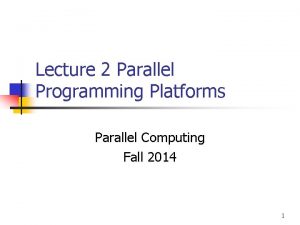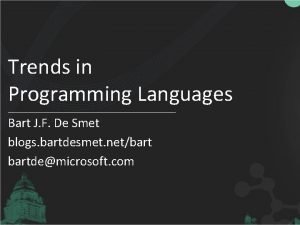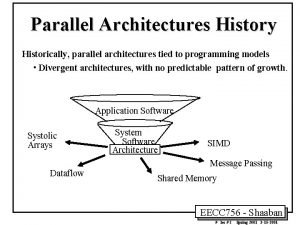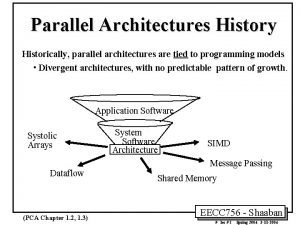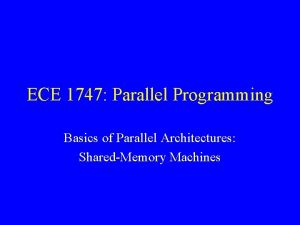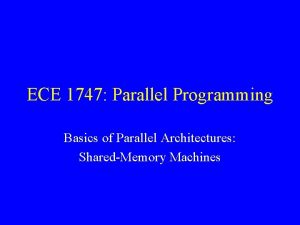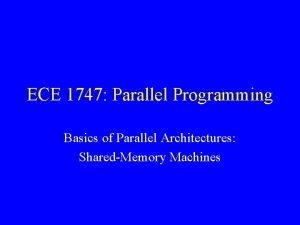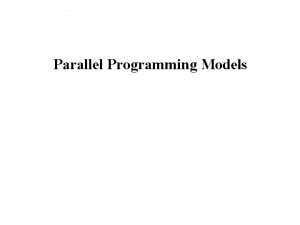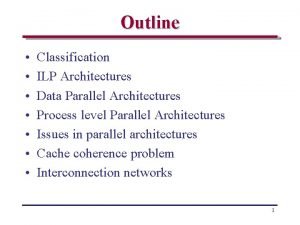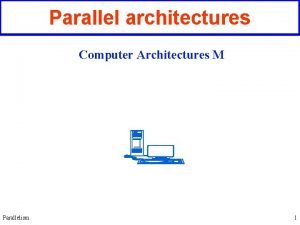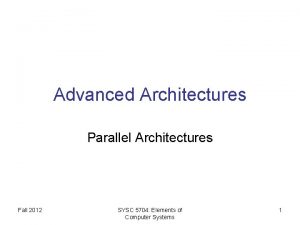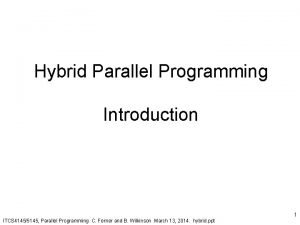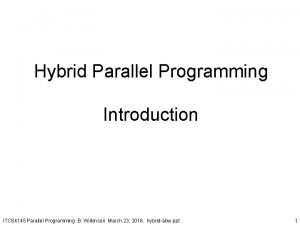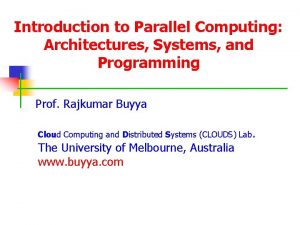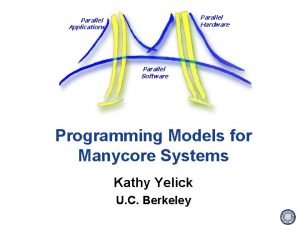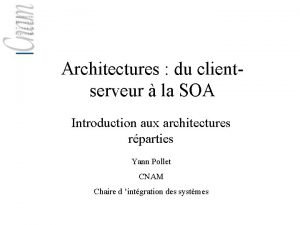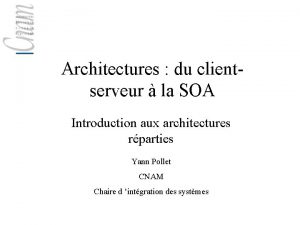Parallel Programming Chapter 2 Introduction to Parallel Architectures




































- Slides: 36

Parallel Programming Chapter 2 Introduction to Parallel Architectures Johnnie Baker January 23, 2011 1

Overview • Some types of parallel architectures – – – SIMD vs. MIMD multi-cores from Intel and AMD Sunfire SMP BG/L supercomputer Clusters Later in the semester we’ll look at NVIDIA GPUs • An abstract architecture for parallel algorithms • Discussion • Sources for this lecture: – Primary Source: Mary Hall, CS 4961, University of Utah – Larry Snyder, http: //www. cs. washington. edu/education/courses/524/08 wi/ – Textbook, Chapter 2 2

An Abstract Parallel Architecture • • How is parallelism managed? Where is the memory physically located? Is it connected directly to processors? What is the connectivity of the network? 3

Why Look at Architectures • There is no canonical parallel computer – a diversity of parallel architectures – Hence, there is no canonical parallel programming language • Architecture has an enormous impact on performance – And we wouldn’t write parallel code if we didn’t care about performance • Many parallel architectures fail to succeed commercially – Can’t always tell what is going to be around in future years Challenge is to write parallel code that abstracts away architectural features, focuses on their commonality, and is therefore easily ported from one platform to another. 4

Viewpoint (Jim Demmel*) • Historically, each parallel machine was unique, along with its programming model and programming language. • It was necessary to throw away software and start over with each new kind of machine. • Now we distinguish the programming model from the underlying machine, so we can write portably correct codes that run on many machines. – MPI now the most portable option, but can be tedious. – Writing portable fast code requires tuning for the architecture. • Parallel algorithm design challenge is to make this process easy. – Example: picking a blocksize, not rewriting whole algorithm. * James Demmel is a distinguished prof of Math & CS at UCB

Shared Memory Six Parallel Architectures (from text) • Multi-cores – Intel Core 2 Duo – AMD Opteron • Symmetric Multiprocessor (SMP) • Sun. Fire E 25 K Distributed Memory • Heterogeneous Architecture (ignore for now) • IBM Cell B/E • Clusters (ignore for now) – Commodity desktops (typically PCs) with high-speed interconnect • Supercomputers – IBM BG/L 6

Multi-core 1: Intel Core 2 Duo • Two 32 -bit Pentiums on chip • Private 32 K L 1 caches for instructions (L 1 -I) and data • Shared 2 M-4 M L 2 cache • MESI cc-protocol provides cache coherency • Shared bus control and memory • Fast on-chip communication using shared memory 7

MESI Cache Coherence • States: M=modified; E=exclusive; S=shared; I=invalid; • Think of it as a finite state machine – Upon loading, a line is marked E, subsequent reads are OK; write marks M – Seeing another load, mark as S – A write to an S, sends I to all, marks as M – Another’s read to an M line, writes it back, marks it S • Read/write to an I misses • Related scheme: MOESI (O = owned; used by AMD) 8

AMD Dual-Core Opteron (in CHPC systems) • Two 64 -bit processors on a chip • 64 K private L 1 data & instruction caches • 1 MB private L 2 cache • MOESI cc-protocol • Direct connect shared memory • Fast on-chip communication between processors 9

Comparison • Fundamental difference in memory hierarchy structure and cache coherency protocol • More details about these protocols in textbook 10

Classical Shared-Memory, Symmetric Multiprocessor (SMP) • • All processors connected by a bus Cache coherence maintained by “snooping” on the bus Serializes communication – usually limiting nr of processors to ~20 AMD Dual Core has architecture well suited to construct an SMP. 11

Sun. Fire E 25 K • An example of SMP • 4 Ultra. Sparcs • Dotted lines represent snooping • 18 boards connected with crossbar switch 12

Crossbar Switch • A crossbar is a network connecting each processor to every other processor • Wires do not Intersect unless a circle connection is shown • Crossbars grow as n 2 making them impractical for large n • Here, only 4 boards are shown, but the Sun Fire D 25 K has 18 boards 13

Crossbar in Sun. Fire E 25 K • X-bar gives low latency for snoops allowing for shared memory • 18 x 18 X-bar is basically the limit due to as n 2 rate of increase • Raising the number of processors per node will, on average, increase congestion • How could we make a larger machine? 14

Heterogeneous Chip Designs • An alternative to replicating a standard processor several times is to augment a standard processor with one or more specialized attached processors • The standard processor performs the general, hard-toparallelize part of computation while attached processors perform the compute-intensive portion of the computation • Examples: – Graphics Processing Units (GPU’s) – Field Programmable Gate Arrays (FPGAs) – Cell Processor, designed for video games

A Heterogeneous Chip: The Cell Processor • Cell processor is a joint development by Sony, IBM, and Toshiba. • Has 64 - bit Power. PC core and eight specialized cores called synergistic processing elements (SPEs) – Each SPE supports 32 bit vector operations. – High speed Element Interconnect Bus (EIB) connecting SPEs – SPEs capable of supporting vector instructions, with one operation performed on several data values in parallel. • Cell emphasizes performance and hardware simplicity over programming convenience. – SPEs do not have coherent memory – Programmers must carefully manage movement of data to and from the SPEs so that the vector units can be kept busy. – When successful, Cell processors can produce impressive throughputs.

Figure 2. 6 Architecture of the Cell processor. The architecture is designed to move data: The high speed I/O controllers have a capacity of 76. 8 GB/s; each of the two channels to RAM runs at 12. 8 GB/s; the capacity of the EIB is theoretically capable of 204. 8 GB/s. 2 -17


Clusters • Parallel computers made from commodity parts • Nodes connected by commodity interconnects, such as Gigabit Ethernet, Myrinet, Infiniband, etc. • Instructions for assembling a typical system such as below are available on WWW. Ø 8 nodes consisting of a 8 -way Power 4 processor with 32 GB RAM, 2 disks Ø One control processor Ø Myrinet 16 port switch plus 8 PCI adapters on 4 boards Ø Open Source software Ø Can also be built using pre-packaged blade servers. More detail on how to build given in textbook.



Supercomputer: Blue Gene/L Node • Below diagram gives logical organization of a BG/L node. • BG/L has 65, 536 dual core nodes • Processors run at a moderate 770 MHz speed 22

BG/L Interconnect • Separate networks for control and data • Can then specialize network implementation for type of message • Also reduces congestion • 3 D torus is for standard interprocessor transfer • Collective network used for fast evaluation of reductions • Entire BG/L expands to 64× 32 • 3 -d torus� collective network 23

Blue Gene/L Specs • BG/L was the fastest computer in the world (#1 on the Top 500 List) when the textbook was published • A 64 x 32 torus = 65 K 2 -core processors • Cut-through routing gives a worst-case latency of 6. 4 µs • Processor nodes are dual PPC-440 with “double hummer” FPUs • Collective network performs global reduce for the “usual” functions 24

Summary of Architectures Two main classes • Complete connection: CMPs, SMPs, X-bar – – CMPs are Chip Multiprocessors Preserve single memory image Complete connection limits scaling to … Available to everyone (multi-core) • Sparse connection: Clusters, Supercomputers, Networked computers used for parallelism (Grid) – Separate memory images – Can grow “arbitrarily” large – Available to everyone with LOTS of air conditioning • Programming differences are significant 25

Parallel Architecture Model • How to develop portable parallel algorithms for current and future parallel architectures, a moving target? • Strategy: – Adopt an abstract parallel machine model for use in thinking about algorithms 1. Review how we compare algorithms on sequential architectures 2. Introduce the CTA model (Candidate Type Architecture) 3. Discuss how it relates to today’s set of machines 26

How did we do it for sequential architectures? • Sequential Model: Random Access Machine – Control, ALU, (Unlimited) Memory, [Input, Output] – Fetch/execute cycle runs 1 inst. pointed at by PC – Memory references are “unit time” independent of location • Gives RAM it’s name in preference to von Neumann • “Unit time” is not literally true, but caches provide that illusion when effective – Executes “ 3 -address” instructions • Focus in developing sequential algorithms, at least in courses, is on reducing amount of computation (useful even if imprecise) – Treat memory time as negligible – Ignore overheads 27

Interesting Historical Parallel Architecture Model, PRAM • Parallel Random Access Machine (PRAM) – Unlimited number of processors – Processors are standard RAM machines, executing synchronously – Memory reference is “unit time” – Outcome of collisions at memory specified • EREW, CRCW … • Model fails to capture true performance behavior for most current architecture. – Synchronous execution w/ unit cost memory reference does not scale (for multi-tasking type executions) – Therefore, parallel hardware typically implements nonuniform cost memory reference 28

Candidate Type Architecture (CTA Model) • A model with P standard processors, d degree, λ latency • Node == processor + memory + *NIC • Key Property: Local memory ref is 1, global memory is λ *NIC is the network interface chip. See pg 48 of text 29

Estimated Values for Lambda • Captures inherent property that data locality is important. • But different values of Lambda can lead to different algorithm strategies 30

Key Lesson from CTA • Locality Rule: – Fast programs tend to maximize the number of local memory references and minimize the number of nonlocal memory references. • Keep as much of the memory access as possible private (i. e. , where λ=1). • As much as possible, use non-private memory access (i. e. , where λ>1) only for communications and not for data movement. • Locality Rule in practice – It is usually more efficient to add a fair amount of redundant computation to avoid non-local accesses (e. g. , random number generator example). This is the most important thing you will learn in this class! 31

Back to Abstract Parallel Architecture • A key feature is how memory is connected processors! 32

Memory Reference Mechanisms • Shared Memory – All processors have access to a global address space – Refer to remote data or local data in the same way, through normal loads and stores – Usually, caches must be kept coherent with global store • Message Passing & Distributed Memory – Memory is partitioned and a partition is associated with an individual processor – Remote data access through explicit communication (sends and receives) – Two-sided (both a send and receive are needed) • One-Sided Communication (a hybrid mechanism) – Supports a global shared address space but no coherence guarantees – Access to remote data through gets and puts 33

Brief Discussion • Why is it good to have different parallel architectures? – Some may be better suited for specific application domains – Some may be better suited for a particular community – Cost – Explore new ideas • And different programming models/languages? – Relate to architectural features – Application domains, user community, cost, exploring new ideas 34

Conceptual: CTA for Shared Memory Architectures? • CTA is not capturing global memory in SMPs • Forces a discipline – Application developer should think about locality even if remote data is referenced identically to local data! – Otherwise, performance will suffer – Anecdotally, codes written for distributed memory shown to run faster on shared memory architectures than shared memory programs – Similarly, GPU codes (which require a partitioning of memory) recently shown to run well on conventional multi-core 09/02/2010 CS 4961 35

Summary of Lecture • Exploration of different kinds of parallel architectures • Key features – How processors are connected? – How memory is connected to processors? – How parallelism is represented/managed? • Models for parallel architectures 36
 An introduction to parallel programming peter pacheco
An introduction to parallel programming peter pacheco Types of modular architecture
Types of modular architecture Database and storage architectures
Database and storage architectures Base system architectures
Base system architectures Switched backbone networks
Switched backbone networks Autoencoders, unsupervised learning, and deep architectures
Autoencoders, unsupervised learning, and deep architectures Scalable internet architectures
Scalable internet architectures Fundamental and incidental interactions
Fundamental and incidental interactions Gui architectures
Gui architectures Database system architectures
Database system architectures Cdn architectures
Cdn architectures Aaron bannert
Aaron bannert 3 tier architecture of data warehouse
3 tier architecture of data warehouse Computer architecture isa
Computer architecture isa Architecture e commerce
Architecture e commerce Distributed systems architectures
Distributed systems architectures Backbone network architectures
Backbone network architectures Gpu cache coherence
Gpu cache coherence Why systolic architectures
Why systolic architectures Computer programming chapter 1
Computer programming chapter 1 History of python
History of python Chapter 1 introduction to computers and programming
Chapter 1 introduction to computers and programming C programming chapter 1
C programming chapter 1 Perbedaan linear programming dan integer programming
Perbedaan linear programming dan integer programming Greedy vs dynamic programming
Greedy vs dynamic programming What is system program
What is system program Linear vs integer programming
Linear vs integer programming Perbedaan linear programming dan integer programming
Perbedaan linear programming dan integer programming Programming massively parallel processors
Programming massively parallel processors Parallel programming patterns
Parallel programming patterns Parallel programming in java
Parallel programming in java Bubble sort parallel programming
Bubble sort parallel programming Mpi critical section
Mpi critical section Programming massively parallel processors
Programming massively parallel processors David kirk nvidia
David kirk nvidia Parallel programming platforms
Parallel programming platforms F# parallel programming
F# parallel programming
